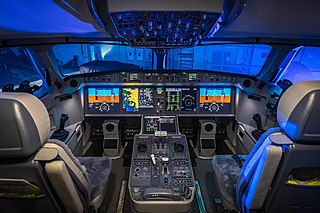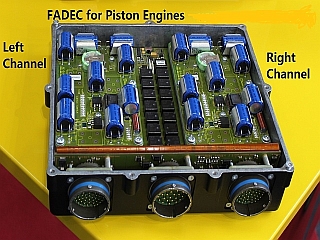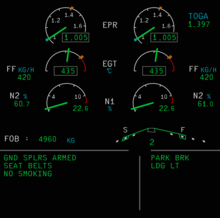
Avionics are the electronic systems used on aircraft. Avionic systems include communications, navigation, the display and management of multiple systems, and the hundreds of systems that are fitted to aircraft to perform individual functions. These can be as simple as a searchlight for a police helicopter or as complicated as the tactical system for an airborne early warning platform.

A cockpit or flight deck is the area, on the front part of an aircraft or spacecraft, from which a pilot controls the aircraft.

A glass cockpit is an aircraft cockpit that features an array of electronic (digital) flight instrument displays, typically large LCD screens, rather than traditional analog dials and gauges. While a traditional cockpit relies on numerous mechanical gauges to display information, a glass cockpit uses several multi-function displays driven by flight management systems, that can be adjusted to display flight information as needed. This simplifies aircraft operation and navigation and allows pilots to focus only on the most pertinent information. They are also popular with airline companies as they usually eliminate the need for a flight engineer, saving costs. In recent years the technology has also become widely available in small aircraft.

A full authority digital enginecontrol (FADEC) is a system consisting of a digital computer, called an "electronic engine controller" (EEC) or "engine control unit" (ECU), and its related accessories that control all aspects of aircraft engine performance. FADECs have been produced for both piston engines and jet engines.

An engine-indicating and crew-alerting system (EICAS) is an integrated system used in modern aircraft to provide aircraft flight crew with instrumentation and crew annunciations for aircraft engines and other systems. On EICAS equipped aircraft the "recommended remedial action" is called a checklist.

Air Transat Flight 236 was a transatlantic flight bound for Lisbon, Portugal, from Toronto, Canada, that lost all engine power while flying over the Atlantic Ocean on August 24, 2001. The Airbus A330 ran out of fuel because of a fuel leak caused by improper maintenance. Captain Robert Piché, 48, an experienced glider pilot, and First Officer Dirk DeJager, 28, glided the plane to a successful emergency landing in the Azores, saving all 306 people on board. Most of the passengers on the flight were Canadians visiting Europe or Portuguese expatriates returning to visit family in Portugal. This was also the longest passenger aircraft glide without engines, gliding for nearly 75 miles. Following this unusual aviation accident, this aircraft was nicknamed the "Azores Glider".

In aviation, an electronic flight instrument system (EFIS) is a flight instrument display system in an aircraft cockpit that displays flight data electronically rather than electromechanically. An EFIS normally consists of a primary flight display (PFD), multi-function display (MFD), and an engine indicating and crew alerting system (EICAS) display. Early EFIS models used cathode ray tube (CRT) displays, but liquid crystal displays (LCD) are now more common. The complex electromechanical attitude director indicator (ADI) and horizontal situation indicator (HSI) were the first candidates for replacement by EFIS. Now, however, few flight deck instruments cannot be replaced by an electronic display.
The Future Air Navigation System (FANS) is an avionics system which provides direct data link communication between the pilot and the air traffic controller. The communications include air traffic control clearances, pilot requests and position reporting. In the FANS-B equipped Airbus A320 family aircraft, an Air Traffic Services Unit (ATSU) and a VHF Data Link radio (VDR3) in the avionics rack and two data link control and display units (DCDUs) in the cockpit enable the flight crew to read and answer the controller–pilot data link communications (CPDLC) messages received from the ground.

S7 Airlines Flight 778(S7778/SBI778) was a scheduled domestic passenger flight from Moscow to Irkutsk, Russia. On 9 July 2006, at 06:44 local time, the Airbus A310-324 aircraft operating the route overran the runway during its landing in Irkutsk. The aircraft failed to stop and crashed through the airport's concrete perimeter fence, struck rows of private garages and burst into flames, killing 125 people.
An Air Data Inertial Reference Unit (ADIRU) is a key component of the integrated Air Data Inertial Reference System (ADIRS), which supplies air data and inertial reference information to the pilots' electronic flight instrument system displays as well as other systems on the aircraft such as the engines, autopilot, aircraft flight control system and landing gear systems. An ADIRU acts as a single, fault tolerant source of navigational data for both pilots of an aircraft. It may be complemented by a secondary attitude air data reference unit (SAARU), as in the Boeing 777 design.
An annunciator panel, also known in some aircraft as the Centralized Warning Panel (CWP) or Caution Advisory Panel (CAP), is a group of lights used as a central indicator of status of equipment or systems in an aircraft, industrial process, building or other installation. Usually, the annunciator panel includes a main warning lamp or audible signal to draw the attention of operating personnel to the annunciator panel for abnormal events or condition.

Qantas Flight 72 (QF72) was a scheduled flight from Singapore Changi Airport to Perth Airport by an Airbus A330. On 7 October 2008, the flight made an emergency landing at Learmonth Airport near the town of Exmouth, Western Australia, following an inflight accident that included a pair of sudden, uncommanded pitch-down manoeuvres that caused severe injuries—including fractures, lacerations and spinal injuries—to several of the passengers and crew. At Learmonth, the plane was met by the Royal Flying Doctor Service of Australia and CareFlight. Fourteen people were airlifted to Perth for hospitalisation, with 39 others also attending hospital. In all, one crew member and 11 passengers suffered serious injuries, while eight crew and 99 passengers suffered minor injuries. The Australian Transport Safety Bureau (ATSB) investigation found a fault with one of the aircraft's three air data inertial reference units (ADIRUs) and a previously unknown software design limitation of the Airbus A330's fly-by-wire flight control primary computer (FCPC).

Air France Flight 447 (AF447/AFR447) was a scheduled international passenger flight from Rio de Janeiro, Brazil, to Paris, France. On 1 June 2009, inconsistent airspeed indications led to the pilots inadvertently stalling the Airbus A330 serving the flight. They failed to recover the plane from the stall, and the plane crashed into the mid Atlantic Ocean at 02:14 UTC, killing all 228 passengers and crew on board.

A flight control mode or flight control law is a computer software algorithm that transforms the movement of the yoke or joystick, made by an aircraft pilot, into movements of the aircraft control surfaces. The control surface movements depend on which of several modes the flight computer is in. In aircraft in which the flight control system is fly-by-wire, the movements the pilot makes to the yoke or joystick in the cockpit, to control the flight, are converted to electronic signals, which are transmitted to the flight control computers that determine how to move each control surface to provide the aircraft movement the pilot ordered.

Cathay Pacific Flight 780 was a flight from Juanda International Airport in Surabaya, Indonesia, to Hong Kong International Airport on 13 April 2010. On board were 309 passengers and a crew of 13. As Flight 780 neared Hong Kong, the crew were unable to change the thrust output of the engines. The aircraft, an Airbus A330-300, landed at almost twice the speed of a normal landing, suffering minor damage. The 57 passengers who sustained injuries were hurt in the ensuing slide evacuation; one of them received serious injuries.

Qantas Flight 32 was a regularly scheduled passenger flight from London to Sydney via Singapore. On 4 November 2010, the aircraft operating the route, an Airbus A380, suffered an uncontained failure in one of its four Rolls-Royce Trent 900 engines. The failure occurred over the Riau Islands, Indonesia, four minutes after takeoff from Singapore Changi Airport. After holding for almost two hours to assess the situation, the aircraft made a successful emergency landing at Changi. No injuries occurred to the passengers, crew, or people on the ground, despite debris from the aircraft falling onto houses in Batam.

Richard Champion de Crespigny is an Australian Qantas pilot and author who served as pilot-in-command of Qantas Flight 32 and was widely praised for his cockpit resource management during the emergency with his crew.

Indonesia AirAsia Flight 8501 was a scheduled international passenger flight operated by Indonesia AirAsia from Surabaya, Java, Indonesia, to Singapore. On 28 December 2014, the Airbus A320 flying the route crashed into the Java Sea, killing all 162 people on board. When search operations ended in March 2015, only 116 bodies had been recovered.

Loganair Flight 6780 was a scheduled domestic flight from Aberdeen Airport to Sumburgh Airport in the Shetland Islands, Scotland. On 15 December 2014, the Saab 2000 operating the flight was struck by lightning during the approach, and then plunged faster than the aircraft's maximum operating speed. The aircraft came within 1,100 feet (340 m) of the North Sea before the pilots recovered and returned to Aberdeen. All 33 passengers and crew were unharmed.

Hop-A-Jet Flight 823 was a chartered U.S. domestic flight operated by Hop-A-Jet from Ohio State University Airport in Columbus, Ohio, to Naples Airport in Naples, Florida. Shortly before landing on February 9, 2024, the pilots reported a dual engine failure and attempted to land on Interstate 75. The aircraft, a Bombardier Challenger 604, was destroyed and consumed by a post-crash fire. Both pilots were killed, but the two passengers and the sole flight attendant on board survived.






















